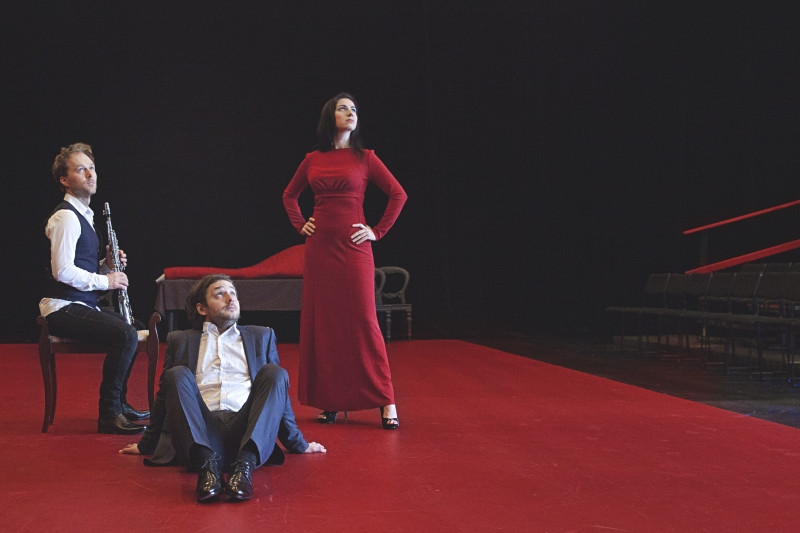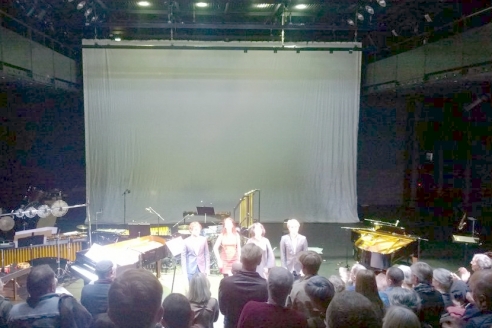
The Fool
When is a concert not a concert? When it’s The Fool. Carefully considered tricks conspired to convince us, the audience, that we weren’t here to listen to five pieces of music being played: the teasing title, the theatrical venue, the dramatic video trailer, and when we arrived at Operaen’s Takkelloftet, the costumes, the lighting and the actors.
But the person responsible for printing the white paper playbill that was handed out at the door clearly wasn’t in on the conspiracy. On the rear side, as if to undermine all the conceptual smoke and mirrors that had been put in place to conceal what The Fool actually was, someone had simply typed out the names of four composers and their respective pieces of music – neatly divided either side of the word ‘pause’. So, it turned out we were at a concert after all.
That’s the thing about The Fool – I’m not sure anybody involved had quite decided what it was.
That’s the thing about The Fool – I’m not sure anybody involved had quite decided what it was. It was marketed as an avant-garde cabaret, sought the spontaneity and currency of a revue, was built on the raw ingredients of a classical concert but was surrounded by the physical apparatus of a theatre piece. The challenge with all that, as anybody knows, is ensuring the project doesn’t wind up delivering an unsatisfactory version of each.
Promising the fearless
Still, The Fool – cooked up by Trio Zoom and mezzo Lore Lixenberg (who also directed) – looked promising. On paper, at least. And on screen too. If you saw the video trailer distributed by The Royal Theatre, you’d have been ready for a performance railing with anger, lunging with physicality, contorting its audio-visual limbs in a celebration of the absurd, the ridiculous, and – that ne plus ultra of surrealism – the fearless. Any genre confusion would have been forgotten fast.
As it was, we moved straight from the pre-show video of Trio Zoom guffawing into three cameras to a performance of Helmut Oehring’s Songs of Comfort and Despair. This is an unsettling piece in its own way, spitting out stanzas from Dylan Thomas over a rich, tonal but muddy sequence of piano chords, stalked by momentary silences and eventually throttling up into pop-rock style communicative directness in its quick-fire ‘snow against iron’ sequence.
Trio Zoom reveled in the intense tread of this music and its shape-shifting rhythmic games. At the piano, Tanja Zapolski nailed the notes with intent but let you know, physically, how much fun it could be but also how much finger technique and communicative discipline it required. Eventually, Lixenberg’s rich, smooth mezzo floated in to deliver an unaccompanied ballad from her seat in the audience.
A tradition of avant-garde
But haven’t we visited this particular corner of auditoria-conceived stagecraft a few times before? Planting singers in the audience was getting a little passé even when Kasper Holten did it in Götterdämmerung (though he just about pulled it off). At Takkelloftet, some of us saw this ruse coming when Lixenberg walked in from the slips to take her seat just before curtain-up. Without wanting to get hung up on professional detail, ‘received’ gestures like these became something of a leitmotif in The Fool. They are ossified elements of a European theatrical tradition, not the radical gestures promised by this show’s ‘avant-garde’ tag.
They are ossified elements of a European theatrical tradition, not the radical gestures promised by this show’s ‘avant-garde’ tag.
The Fool’s stage rubric there and elsewhere proved unable or unwilling to shake off the formality of tradition – notably when proceedings drifted into the sterility of a classical concert, rendering the behavior of the add-on actors doubly awkward. There was a certain reverence in the air. Musicians walked around the stage as if participants in a sacred ceremony, careful not to make extraneous noises when extraneous noises would have provided a neat counterpoint to all the extraneous physical action. Much of the musical delivery was wrapped in a sort of whimsy. Only Zapolski seemed to be enjoying it fully, fighting the formality of the production as she did so but still, apparently, commanded not to look us, the audience, in the eye.
That spilled over into some aloof performances, notably a rendition of Rolf Hind’s Varanasi Haiku that lacked character, saxophonist Stefan Baur sounding as woolly here as he did direct and edgy elsewhere. Perhaps that’s what the score to this elusive, meditative piece instructs. If so, the piece wasn’t a good fit for the show.
Hot-dogs at the interval
Hind’s This Is the Cow, by contrast, was. This is a canny little work, subjecting a contradictory and naïve text to absurd musical contours and asking a lot – and a lot that’s new – of the human voice. Lixenberg’s sprechgesang eventually coiled itself into an intense counterpoint with Zapolski’s, while seismic thwacks on a bass drum propelled the music towards its black comedy conclusion: Baur freaking out on his saxophone as the big screen broadcast pictures of a cow attempting, horribly, to back away from the slaughter chamber.
Meanwhile, someone cooked beef sausages to the rear of the stage.
Meanwhile, someone cooked beef sausages to the rear of the stage. But we knew they would, because the camping stove had been waiting there from the start. Nor was it much of a surprise that we were offered free hot-dogs just before the interval.
During that interval, the same big screen showed Trio Zoom in an Operaen dressing room, dressed in toweling robes, chatting dysfunctionally, sipping beer from cans. In the background, a television showed a small dog attempting to engage in sexual activity with a piece of fabric.
You can conclude from that what you like. But there’s a good argument the sequence had more multifaceted wit than almost anything non-musical that happened on the stage. The Fool’s kooky little films unintentionally torpedoed the elements of live theatre because their imaginative reach was far broader, the performances freer and more natural. There was Chaplinesque refinement in the film of the Trio attempting to change costume while continuing to hold/support their instruments.
Best of all was a sequence in which all four musicians displayed unbounded malice, violent intent and apparent loss of reason, physical control and interpersonal communication during what appeared to be the break in a rehearsal. It was amusing and terrifyingly real as it oscillated between banter and brutality.
Adapting to absurdity
But as soon as that ended, we were back to a group of inconsistently dressed musicians on a cluttered stage playing experimental music. Now and then, an actor would do something – saunter in front of the instruments holding the aforementioned dog, for instance. It was incongruous, but that’s fine – life and art are incongruous too. The trouble is that it does something of a disservice to the composers whose music is being played.
It was tender, reflective, stupid and smile inducing and lined with sadness too, the text veering from the vulnerable to the gauche.
Niels Rønsholdt endearing score Shame was either strong enough to overcome that or best suited to the atmosphere and the space (I suspect the former). Its childlike, first person narrative was delivered in tender speech-song by Zapolski (and somehow doubled at two octaves like a sonic reflection sucking helium), who also provided the piano chords that moved from the droll to the rhapsodic underneath.
A guitar strummed while the vocal gently simmered, growing in honesty, pain and determination. It was tender, reflective, stupid and smile inducing and lined with sadness too, the text veering from the vulnerable to the gauche. But after it, The Fool shifted gear awkwardly once again, now in the direction of Richard Thomas’s The Anger Demon.
Connection lost
The Anger Demon’s primary trick – as in Thomas’s Jerry Springer the Opera – is its elaborate, synth-baroque setting of everyday vernaculars such as ‘fuck you’. It is, in fact, a series of ‘fuck you’ ritornellos separated by verbatim settings of popular YouTube rants (from Christian Bale to Noam Chomsky).
Eventually her gaze alighted on a well-to-do gentleman sat in the middle of the front row, to whom she delivered a final, flourishing ‘fuuuuuuck yooooooou!’
It’s also a neat if transient piece of comic musical theatre, refreshing in its planting of absurdity, banality and profanity within the musical rhetoric of Broadway and the operatic stage. Thomas’s direct way with text setting has instant appeal that short-circuits the music’s own plasticity. Lixenberg’s delivery was deliciously risqué in its addressing of individual ‘fuck yous’ to what felt like every individual member of the audience. Eventually her gaze alighted on a well-to-do gentleman sat in the middle of the front row, to whom she delivered a final, flourishing ‘fuuuuuuck yooooooou!’
 The performance has ended. Copyright: Andrew Mellor
The performance has ended. Copyright: Andrew Mellor
The Anger Demon should have addressed The Fool’s laughter deficit, but in reality even here the laughs were intermittent, muted or uneasy. What it did, instead, was underline the show’s strained relationship with the idea of theatre. I simply don’t think the audience was prepared for its sudden brightness, its primary colours. Being told to ‘fuck off’ hundreds of times having just emerged from Rønsholdt’s delicate, questing Shame was unfair on The Anger Demon’s Broadway DNA; we hadn’t had an appropriate aesthetic warm-up. Here was a sure sign that The Fool had failed to foster a meaningful relationship with its audience, a good number of whom had drifted out.
Here was a sure sign that The Fool had failed to foster a meaningful relationship with its audience, a good number of whom had drifted out.
Would the whole enterprise have been more effective stripped of its title, its theatrical clutter, and arranged as a performance of music by four provocative living composers in a concert hall? That might be an irrelevant, unfair question. But I emerged from The Fool longing to hear Zapolski, perhaps with her fellow trio members, playing music in a clean, quiet white room with no costumes or actors or camping stoves in sight.
As it was, the many component parts of The Fool either stamped on each other’s toes or appeared to suffer from stilted development. Likewise, the free hot-dogs that were handed out after Rolf Hind’s This Is the Cow, complete with a little paper message from Hind reminding us that an animal had died in the service of this needless piece of faux-theatre: Fine – but at least finish the job with some onion, ketchup and mustard.


